This post contains affiliate links for products we love. Fusion Craftiness earns a small commission on these links at no cost to you.
A classic Chinese restaurant staple, Lo Mein is a quick and easy meal that is perfect for busy weeknights. This favorite of ours does double duty, it cleans out the leftovers in the fridge and get’s dinner on the table fast.
This article will teach you how to make Lo Mein like a pro, and also explore some of the history and variations of this delicious dish. This quick and easy meal is perfect for busy weeknights. This favorite of ours does double duty, it cleans out the leftovers in the fridge and get’s dinner on the table fast. Forget Chinese Takeout, make your own!
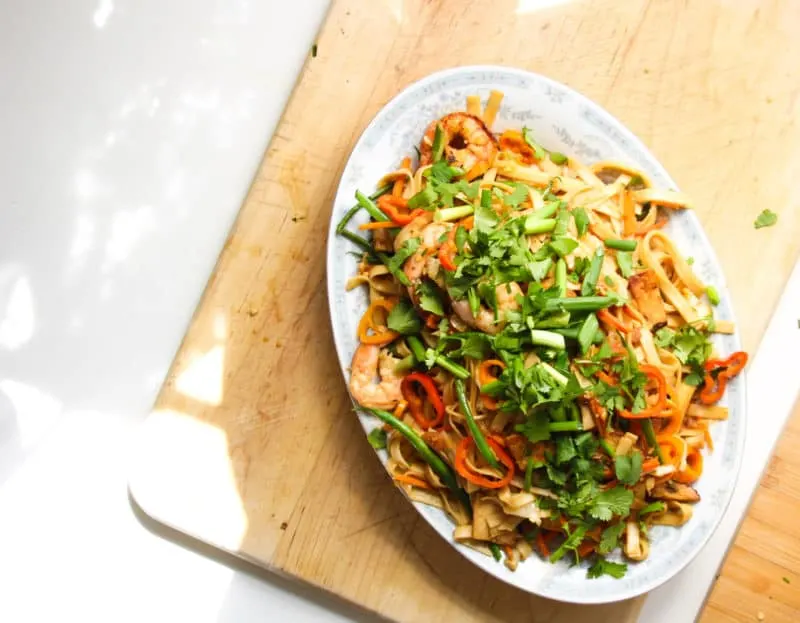
My Lo Mein Story
My parents always loved ordering Chinese takeout. They would get lo mein almost every time, and they always seemed to love it. I remember one time in particular when they ordered a ton of lo mein from our local Chinese restaurant. I was really hungry, so I decided to help myself to a plate of lo mein.
I took a bite of the lo mein and it was absolutely amazing. I couldn’t believe how good it was, and I ended up eating way more than I should have. In the end, I was really glad that my parents had ordered so much lo mein, because it was definitely the best Chinese takeout I had ever tasted.
Lo mein is a dish that has a long and complicated history. It is thought to have originated in China, where it was known as lamian. Lamian noodles are a type of Chinese noodle made from wheat flour. Lamian noodles are often hand-pulled and can be thick or thin. They are popular in the northern regions of China where they originated. These noodles can be served with various toppings, including meat, vegetables, and seafood.
Lo Mein is a Cantonese noodle dish known for its delicious blend of flavors and textures. This dish typically consists of noodles, vegetables, and protein cooked in a flavorful sauce. It is also versatile enough to include various ingredients like mushrooms, beef, pork, chicken, shrimp, tofu or a combination of any of these.
One of the most popular variations is Chicken Lo Mein. This version replaces the pork with chicken, and typically includes additional ingredients such as mushrooms and onions. Another common variation is vegetable Lo Mein, which replaces the meat with an assortment of fresh vegetables.
What Is The Difference Between Lo Mein and Chow Mein?
Lo Mein is an incredibly popular noodle dish originating from China. The word “mein” means noodles, so any dish you order with “mein” in the title or description will always come with noodles.
Lo Mein and Chow Mein are two very similar dishes that many people get confused. The main difference between Lo Mein and Chow Mein is how the noodles are prepared. “Chow” means “stir-fried”, and Chow Mein noodles are often made to be crispy. “Lo” means “stirred” or “tossed”, and these noodles have a softer, spaghetti-like texture.
For more information on the differences between these two dishes, check out my article on Chow Mein vs. Lo Mein.
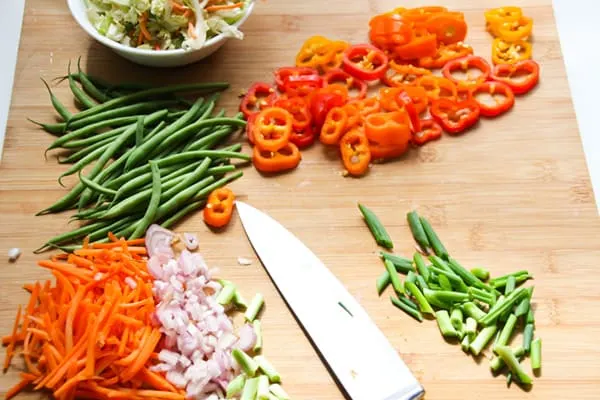
What Is House Special Lo Mein?
One of the best attributes about Lo Mein is how open-ended the recipe is. As long as you use parboiled wheat-based egg noodles, you’ve got Lo Mein.
There are many varieties of traditional Lo Mein. Many variations of Lo Mein use sea food, such as shrimp or lobster, as the primary protein and source of flavor. If seafood isn’t your thing, look out for chicken, beef, pork, or vegetable Lo Mein. The possibilities are endless!
If you walk into a Chinese restaurant and you’re craving some delicious noodles, keep an eye out for “house special” Lo Mein. These dishes are different depending on the restaurant you go to, and house special Lo Mein can offer a brand-new culinary experience.
These Lo Mein recipes are often unique to that one restaurant. Since Lo Mein is a very flexible dish, the ingredients used in house specials are going to vary widely. One thing that’s common among all house special Lo Mein recipes is the use of many different meats.
Whereas shrimp Lo Mein might only use shrimp, a house special Lo Mein at the same restaurant might include shrimp, oysters, and lobster all in one. It all depends on which meats the cooks decide to use together!
What Type of Protein Can I Use for This Recipe?
There are many different types of meat and protein that can be used for lo mein recipes. Some of the most popular proteins include shrimp, chicken, beef, and pork. However, there are many other options that can be used as well.
Shrimp or crawdads are a popular seafood choice for lo mein, and variations that include other types of seafood are also common.
If you’re looking for something a little different, try using tofu, eggs, edamame or tempeh as your main protein source for a vegetarian option. The possibilities are endless!
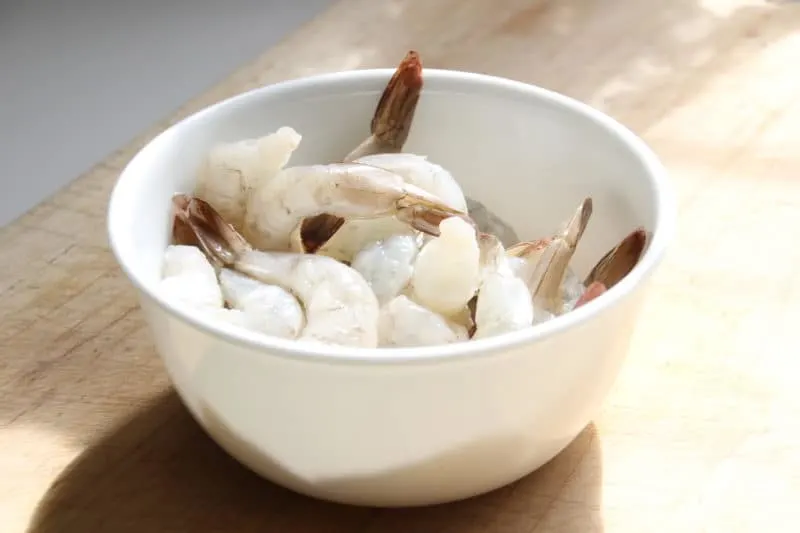
What Kind of Noodles Are Used For Lo Mein?
Typically, a wheat based egg noodle is used for Lo Mein. You can easily find noodles labeled ‘Lo Mein Noodles’ in your average American supermarket that are probably priced much higher than pasta.
Yes, you can use pasta. Good pasta choices include fettuccine, tagliatelle, pappardelle, bucatini, linguine and even spaghetti. These pastas are wheat based and have egg. They have that nice, chewy texture that ‘Lo Mein’ noodles have and chances are, you have some of these pastas in your pantry right now.
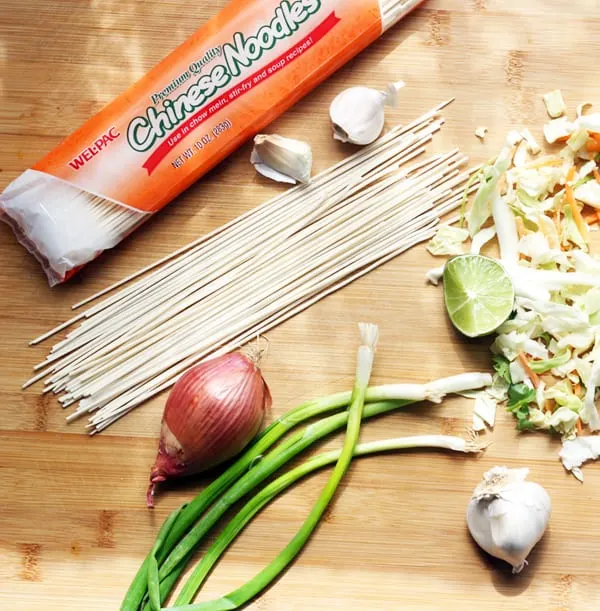
Ingredients for Lo Mein
Lo Mein Sauce
Many types of seasonings or sauces can be used for cooking lo mein. Some of the most popular sauces include soy sauce, oyster sauce, and hoisin sauce. However, there are many other options that can be used as well.
For a traditional lo mein dish, soy sauce is always a good choice. It provides a salty flavor that goes well with the noodles and vegetables. Oyster sauce is another popular choice because it add a rich and savory flavor to the dish. Hoisin sauce is also a great option because it gives lo mein a slightly sweet and spicy flavor.
The sauce is up to you. If you shy away from making your own sauces you can buy pre-made Asian stir-fry sauce in your local market.
If you are more adventurous, make your own. Below are some common ingredients in Lo Mein or any stir-frys, not just Chinese dishes.
Just pick 2-6 ingredients and mix together. You will want a total of 1-2 tablespoons of sauce per person that you are cooking for. Be careful of the salty* ingredients, you may want to just stick to one or two of those ingredients.
- light or dark soy sauce* (use both if you can)
- fish sauce*
- Hoisin sauce*
- Oyster sauce*
- honey
- brown sugar
- grated ginger
- vinegar – white, rice, white wine, apple cider or any of the lighter colored vinegars
- citrus juice and zest – lime, lemon, orange, grapefruit
- sambal – hot pepper paste
- Gochujang – Korean hot pepper paste
- Plum sauce – a sweet sauce
- miso paste* – fermented bean paste, umami in a jar
- Teriyaki sauce*
- toasted sesame oil
- mirin
- white or brown sugar
- toasted sesame seeds
Crisp Tender Vegetables
Clean out your fridge of leftover vegetables from this weeks cooking. Lo Mein can be a great Friday night quick dinner.
Feel free to use any of these veggies:
- green onions
- shredded carrots
- green, yellow or red bell peppers
- napa cabbage
- baby bok choy
- bean sprouts
- snow peas
- broccoli
- spinach
- kale
- mushrooms
- water chestnuts
- bamboo shoots
Lo Mein Noodle Types
Use any wheat noodle or pasta you have on hand. Here are all the noodles to look for when making this dish. You can use fresh or dried noodles and pasta.
- egg noodles
- gluten free pasta
- angel hair pasta
- asian noodles
- italian pasta
- ramen noodles
- cooked lo mein noodles
- spaghetti
- fettuccine
- tagliatelle
- pappardelle
- bucatini
- linguine
- rice noodles
- udon noodles
- soba buckwheat noodles
Optional Garnishes
- scallions
- toasted sesame seeds
- crispy fried noodles
- diced bell pepper
Todays Weeknight House Special Lo Mein Version
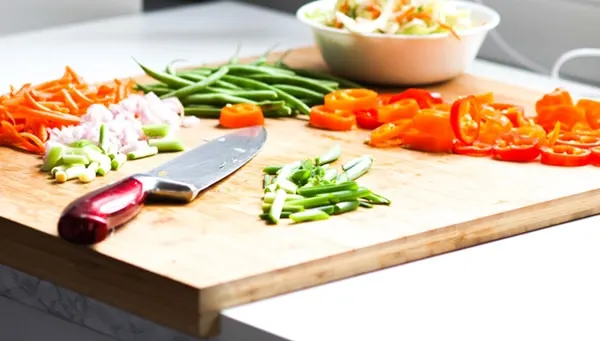
This version is a clean out your fridge and pantry recipe that can be on the kitchen table fast. This version uses up leftover veggies in your fridge and pasta and Asian condiments you have lingering around. You can also throw leftover meat in there from other dishes such as rotisserie chicken, lunch meat and brisket.
If you don’t have leftovers, no worries. Just grab some of your favorite veggies at the supermarket and some meat of your choice. Meat that is already cooked is the easiest but you can buy raw meat too. It will require the extra step of slicing it thin or cutting into bite-sized pieces but should cook really quick in a hot skillet.
How to Cook Lo Mein
First Step
Cook your noodles until al dente, or just before it is finished. Just shave off two minutes of cooking time so that the noodles or pasta can finish cooking in the skillet. Drain the noodles and rinse with cold water to stop the cooking. Set aside.
While the noodles are cooking, raid your fridge of veggies and meat. Chop and dice these and set aside.
Second Step
Make your sauce. Using the list above mix a few ingredients for your sauce. If you are using a pre-made sauce such as Hoisin, just add one or two more ingredients such as an acid (vinegar or citrus) and a sweetener. Set aside.
Third Step
Heat up a large skillet with some cooking oil in it over medium high heat. Add your most dense veggies first, typically onions, carrots, broccoli and stir frequently. Cook for a few minutes until they start to soften. Add the rest of your veggies along with garlic and ginger if using. Stir frequently. Set aside in a large bowl.
Add the meat to your skillet until heated or cooked through, add the veggies back, noodles and pour the sauce over the entire dish. Toss for one or two minutes. Serve immediately.
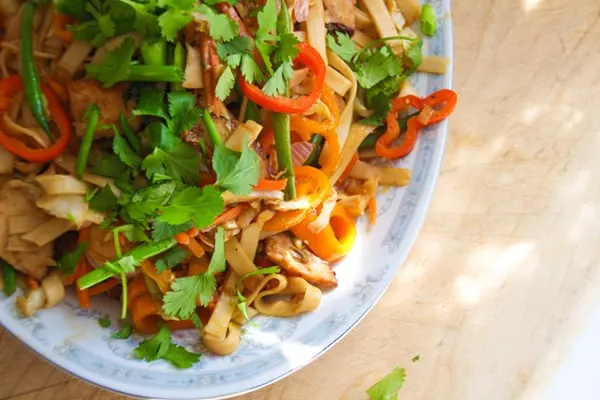
FAQ
Is Lo Mein healthy?
Lo mein is a delicious, popular Asian dish made with wheat noodles and vegetables. While lo mein is usually not known as a healthy dish, it can be made healthier by using whole-wheat noodles or buckwheat noodles, and adding more vegetables. You can also make your own lo mein sauce using low-sodium soy sauce, rice vinegar, and sesame oil. This will give your lo mein dish a healthier and more flavorful taste.How do I make lo mein more interesting?
What are the different types of Lo Mein?
There are many variations of lo mein, but all share a few common characteristics. The basic ingredients are noodles, vegetables, and a meat or seafood protein. The noodles can be cooked fresh or dried, and the vegetables can be cooked in a variety of ways. The most common way to cook lo mein is to stir-fry the ingredients together in a wok or large skillet.There are endless variations of lo mein, but some of the most popular include vegetarian, chicken, shrimp, pork or beef.
Is it vegan friendly?
While lo mein is generally seen as a high-carbohydrate dish, it is possible to make lo mein keto friendly by omitting the noodles and doubling the amount of vegetables. For example, a lo mein dish could be made with shirataki noodles, which are a keto-friendly noodle alternative made from tofu.
What are the benefits of cooking lo mein?
Less food waste by cleaning out your fridge of leftover vegetables and meat.
How can I stretch this dish out to feed more people?
The simple answer is to add more ingredients but you could also serve an appetizer like egg rolls, soup, salad or bread and butter and serve smaller servings of the main dish.
What are some of the best lo mein tips?
While the noodles are cooking, raid your fridge of leftover veggies and meat. Chop and dice these and set aside. Taste as you go so that you can adjust your seasonings.
No matter how you make it, lo mein is sure to be a hit with the entire family. Serve it as a main course or side dish and enjoy its delicious flavors and textures.
If you like noodles dishes, Chicken Lo Mein is an easy weeknight recipe that will also use up leftover veggies from the fridge.
Did you make this recipe? Don’t forget to rate the recipe and comment below! Take a picture and tag us @FusionCraftiness #FusionCraftiness on Instagram for a chance to be featured in our Insta Stories:)
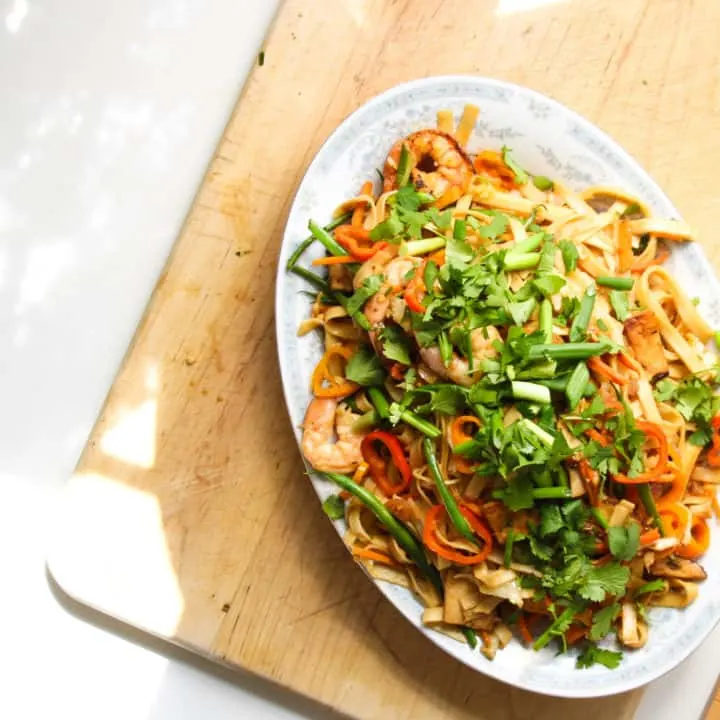
House Special Lo Mein Recipe
House Special Lo Mein is an easy recipe that will get dinner on the table fast. Using leftover vegetables, parboiled noodles and meat, this stir fry comes together in no time. Forget takeout, make some Lo Mein.
Ingredients
- 12 oz Lo Mein noodles (may substitute linguine, spaghetti or fettuccine)
- 3 Tbs cooking oil
- 6 cups of fresh vegetables (see note*)
- 1 Tbs ginger, minced
- 2 tsp garlic, minced
- 1 lb of shrimp, shelled and deveined
- 1/2 lb of cooked chicken
- 1/2 cup of Asian sauce (stir fry sauce, Lo Mein sauce, Hoisin sauce, Oyster sauce, see note*)
Optional Garnishes
- cilantro
- scallions
- peanuts or cashews
- sesame oil
- chili oil or Sriracha
- lime wedges
Instructions
- Cook Lo Mein noodles according to package directions. If using pasta, cook until al dente, or almost cooked fully.
- While the noodles are cooking, chop, dice and slice your vegetables into small pieces or slices. Set aside.
- Set aside your cooked meat and sauce.
- When noodles are done, strain and rinse with cold water to stop the cooking, set aside.
- In a large cast iron skillet or other large pan, heat oil over medium high heat until it starts to shimmer or smoke. Add your densest vegetables first such at onions, carrots and broccoli. Stir frequently until veggies start to soften. Add the remaining vegetables, garlic and ginger. Stir frequently until veggies are cooked al dente. Empty onto a serving platter.
- Add a little more oil to the skillet and add the meat. Heat up the meat and stir constantly for one minute. Add the noodles and the sauce, tossing for two more minutes. Pile onto the serving platter and gently toss. Garnish liberally and serve immediately.
Notes
- I like to use leftover vegetables in my fridge but if you don't have any leftovers pick up some veggies at the market. Good ones for this type of stir fry are pre-julienned carrots, onion, broccoli, green beans, sweet peppers, any type of cabbage including pre-shredded slaw mix, or pre shredded Asian salad mix.
- You can buy pre-made Lo Mein sauce, this is very convenient. You could also make your own if you have some random Asian ingredients. Refer to the list in the article above for some ideas.
- I used shrimp I had in my freezer and chicken deli meat that was thickly sliced. This was very convenient. You can use raw meat, just be sure to slice thin and cook through. Preparing raw meat adds some time. Leftover rotisserie chiken, brisket or roast beef is perfect for this dish.
- This recipe is very versatile, easy and can help you clean out your fridge of leftovers. Be sure to add this to your regular rotation.
Recommended Products
As an Amazon Associate and member of other affiliate programs, I earn from qualifying purchases.
-
 House Of Tsang Sauce Stirfry Classic (Pack of 2)
House Of Tsang Sauce Stirfry Classic (Pack of 2) -
 Healthy Cooking Utensils Set - 6 Wooden Spoons For Cooking – Natural Nonstick Hard Wood Spatula and Spoons – Uncoated and Unglued – Durable Eco-friendly and Safe Kitchen Cooking Tools.
Healthy Cooking Utensils Set - 6 Wooden Spoons For Cooking – Natural Nonstick Hard Wood Spatula and Spoons – Uncoated and Unglued – Durable Eco-friendly and Safe Kitchen Cooking Tools. -
 Mercer Culinary Millennia Black Handle, 8-Inch, Chef's Knife
Mercer Culinary Millennia Black Handle, 8-Inch, Chef's Knife -
 Thai Oyster Sauce Maekrua Brand - Thai Original. (Original Version)
Thai Oyster Sauce Maekrua Brand - Thai Original. (Original Version) -
 TableCraft 32405 Bamboo Handle Wok Spatula, 14.5-Inch
TableCraft 32405 Bamboo Handle Wok Spatula, 14.5-Inch -
 Hiware Solid Stainless Steel Spider Strainer Skimmer Ladle, 5.4 Inch
Hiware Solid Stainless Steel Spider Strainer Skimmer Ladle, 5.4 Inch -
 Lodge Cast Iron Skillet with Red Silicone Hot Handle Holder, 12-inch
Lodge Cast Iron Skillet with Red Silicone Hot Handle Holder, 12-inch
Nutrition Information:
Yield: 6 Serving Size: 1Amount Per Serving: Calories: 483Total Fat: 20gSaturated Fat: 3gTrans Fat: 0gUnsaturated Fat: 15gCholesterol: 195mgSodium: 1173mgCarbohydrates: 40gFiber: 10gSugar: 9gProtein: 35g

Bianca is a graduate student at the University of Cincinnati. She is an Applied Behavioral Health Technician and a freelance writer. She spends her free time catching up with friends and scaling walls at indoor rock gyms.
